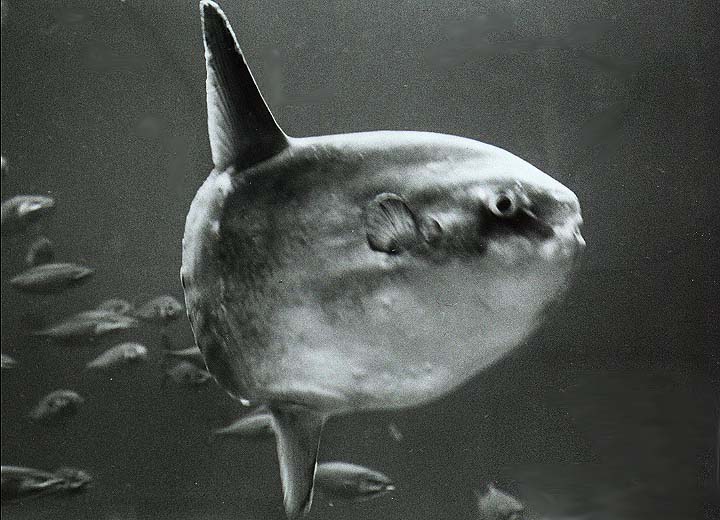

In my youth I used to catch largely undersized sunfish with a fly rod in the lakes of Illinois. My catch paled compared to the sunfish I encountered when I arrived here on Catalina. The ocean sunfish, known scientifically as Mola mola, would have snapped my fly rod just by swimming near my hook! Molas can reach 10 feet in length and 4,000 pounds (although most only get up to 2,000). Look at some of the early fishing photos around town to get a feel for their size. Most of the ones I've seen have been much smaller... up to a few hundred pounds.
These huge fish are found worldwide in tropical and temperate waters. On "our" coast they are seen from British Columbia to South America. In our region they are usually summer and fall visitors, although I used to see them year-round in the 1960's and 1970's. Divers have seen them close to shore, even on the edge of our Casino Dive Park. According to researcher Dan Cortamil at Long Beach State, they dive deep to feed during the day and are inactive during the night, usually resting within 20 m of the surface.
Sunfish usually feed on soft-bodied midwater species like jellyfish or salps, but will also feed on fish and bottom-dwellers including crabs or brittlestars. Hard to believe anything could get so big eating such food! According to Dr. Milton Love, scientists at the Monterey Bay Aquarium discovered that molas would readily switch from jellyfish to fish, or even higher priced shrimp if offered... and then refuse to eat jellyfish again. You can hardly blame them. Ocean sunfish are known to spit when they feed. They will spit a stream of water to tear apart a jellyfish before eating it. One apparently spit in the face of a visitor to the Aquarium when he persisted in tapping on the glass wall of its tank.
Several observers have reported that ocean sunfish are savagely attacked by sea lions when they venture close to shore. The sea lions may "play" with them, biting their fins off, or even eat the entire fish. Not my idea of the ideal playmate!
One of my early encounters with a mola was while collecting drifting kelp rafts in 1969 as part of my research at the Catalina Island School in Toyon Bay. I was leaning over the swim step of the K.V., our dive boat, pulling a large kelp raft into the boat for analysis. As I looked down in the water for the kelp holdfast, I saw what I thought was a shark coming up at me. I should add that I was not wearing my glasses (they'd do little good at 400 feet if they fell off). The "shark" turned and I realized it was an ocean sunfish coming up to check me out.
Apparently ocean sunfish are plagued with parasites. Divers have observed cleaner fish picking these parasites off the mola when they venture into the shallow waters of kelp forests. In the open ocean where the molas spend most of their time, there are very few fish that can clean them. In the early 1970's during my research at Toyon, one of my students and later teaching assistant (Barry Aires) discovered that molas apparently have evolved a very interesting form of communication to solicit cleaning behavior by seagulls.
Barry was out collecting kelp rafts when he saw several ocean sunfish in the water near one of the rafts, a fairly common occurrence. However the mola was at the surface waving its long dorsal fin in the air. It would flap back and forth and drew the attention of a Heerman's gull. The gull landed next to the mola and the fish rolled over on its side. The gull proceeded to clean parasites off the mola's fins with its bill. When it finished, it flew away. The mola returned to its upright position and continued flapping its dorsal fin until the gull returned to finish the job. This behavior was observed a few more times over the years and was also reported later by other scientists.
To Barry and I it was almost as unique as extra-terrestrials communicating with humans. You do believe in life elsewhere in the Universe don't you? After I finish diving our seven continents (four down, three to go), I hope to dive another planet... maybe Mars if they discovered water there during its close approach last month. Of course some have suggested I may already be from another planet... and they were my "friends."
© 2003 Dr. Bill Bushing. Watch the "Dive Dry with Dr. Bill" underwater videos on Catalina Cable TV channel 49, 10:00 AM and 5:00 PM weekdays.

Image caption: Ocean sunfish, the "swimming head"
This document maintained by
Dr. Bill Bushing.
Material
© 2003 Star Thrower Educational Multimedia